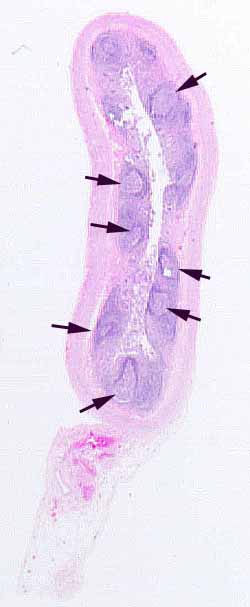
The source for this specimen should be obvious (and confidently so), provided you are familiar with the organ it represents. The sample is normal, not pathological.Note the various distinct layers.
- Name these layers.
Which organs have such distinct layers?
Note the overall size of the specimen. Note that the specimen is complete, including the entire circumference of the organ as well as some supporting connective tissue.
Note specific features of the mucosal layer.
- What are the prominent patches (arrows) composed of many small cells with round nuclei? Note the clear distinction between the paler centers of and darker caps of these patches.
- What shape is the mucosal surface?
- How many different kinds of epithelial cells comprise the surface epithelium?
- Although most of the surface epithelium has been lost (a fairly typical post-mortem change), some characteristic epithelium can still be easily seen in protected sites deep in the mucosa.
- Can you see a distinct muscularis mucosae?
Are there any distinctive features in the submucosa?
Is the muscularis externa organized into distinct layers? What kind of muscle comprises the muscularis in this specimen?
This slide should be easy. The overall size and the presence of so many lymph nodules in the mucosa are typical of only one organ. Other details of mucosal epithelium and other layers are consistent with this site.
There are no more hints.
